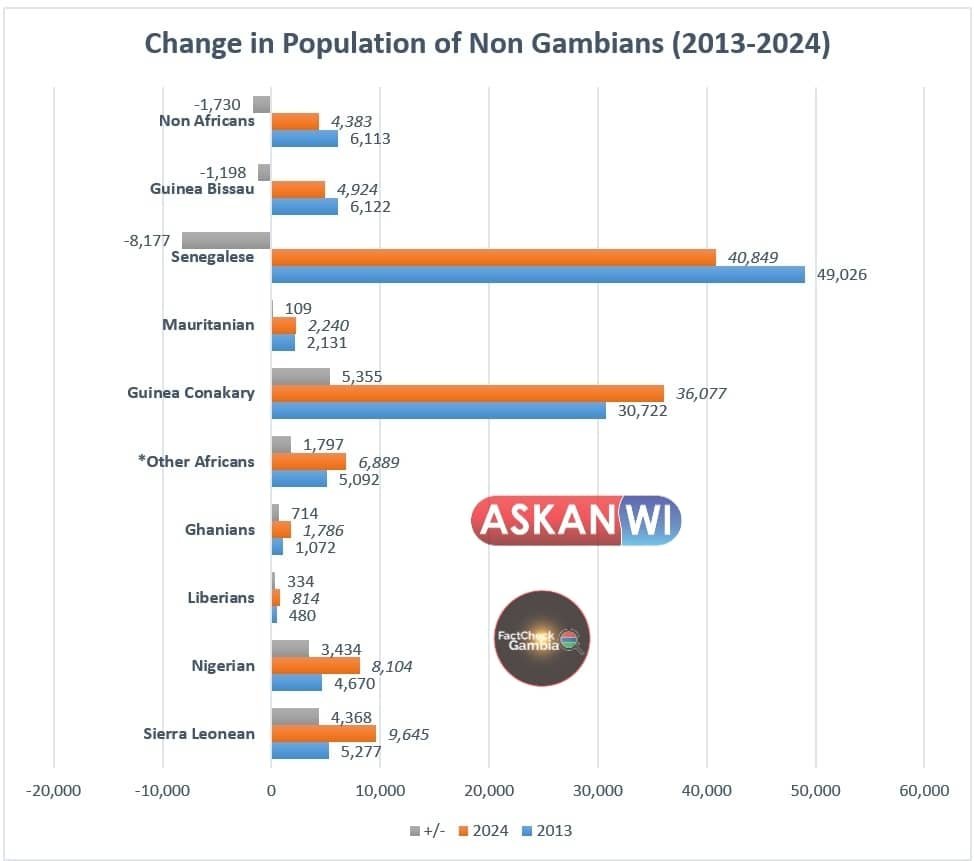FactSheet: Almost Half of Gambia’s Population Live in the West Coast
By Fatou Jaiteh
The Gambia’s Bureau of Statistics (GBOS) published the 2024 Census on 11th September 2024, delaying it’s scheduled April 2023 publish date for over a year. According to the 2024 Census Foreword, since 1973 a census has been undertaken and published every 10 years. However, 51 years of this tradition has been broken after the latest Census was published sixteen months after its due date. The last time the census was postponed was the “1941 Census due to the Second World War. Also, the 1961 Census was postponed to 1963 due to general elections that were planned for that year”.
Our comparison of the 2013 Census and the 2024 Census has enabled us to indicate some of the major changes in The Gambian and Non-Gambian population in the country. Some concerns raised about the non-Gambian Population have also been looked into through this publication. A comparison of the two Census results highlights that almost half of the population live in the Brikama Local Government Area (LGA), meanwhile the population of Banjul is the only LGA with a declining population while non-Africans, Senegalese and people from Guinea are leaving the country.
Over 43% of Gambians Are Considered Dependents
The 2024 Census highlights that the total population increased by over 565 thousand people. The percentage of women and men appear to be identical from the 2013 Census to the 2024 Census with both indicating that women form 51% while men form 49% of the population.
Looking at the age categories it can be seen that the Gambia has a very Youthful and Young population. More than 40% of the population are under the age of 15, while over 36% are between the ages of 15 and 34 years. On the other end of the age demographics, only 22.7% of the population are 35 years and over.
According to the 2024 Census, with 40.8% of the population under 15 years and only 3% aged 65 years and over, this means that approximately 43.8% of the population are considered dependents which “is likely to put pressure on the working age population. As the young population ages into the workforce, targeted investments will be crucial for capitalizing on the potential demographic dividend and addressing the associated challenges”.
Almost Half of the Population Live in Brikama (WCR)
Our comparison of the population of various local government areas shows that Banjul was the only region where the population declined (-15%). Since 2013 to date over 4,500 Banjulians left the city. On the other end of the spectrum, Brikama registered the greatest increase in population by 67% which translates to a whopping 462,384 people.
To demonstrate how significant this increase is, the population of the next biggest Local Government Area (Kanifing) has only 379,348 people according to the 2024 Census. This highlights that the population of Brikama increased by more than the entire population of Kanifing. In total approximately 48% of the population reside in Brikama which covers the entire West Coast Region and not just Brikama.
Over 8 Thousand Senegalese Have Left the Country from 2013
Given the huge concerns raised on the non-Gambian population, our research conducted looks at the data of non-Gambians as recorded by the 2013 Census and compared this to the 2024 Census. Our analysis shows that the number of non-Gambians increased by 5,941 people from 2013 to the latest census.
The nationality which registered the biggest increase is Guinea Conakry which gained an additional 5,355 more people than it did in 2013. It’s worth noting that the population of Senegalese (-17%), Guinea Bissau (-20%) and non-Africans (-28%) were the only non-Gambians to decline in size from 2013 to 2024. The rest of the other non-Gambians all increased by population in The Gambia during the same period. The population with the highest percentage increase are Sierra Leoneans (83%), Nigerians (74%), Liberians (70%) and Ghanaians (76%) to name a few.
Looking at the percentage of non-Gambians in the country, Senegalese (35%) are still the biggest constituent even though their population has declined, followed by Guinea Conakry (31%) and then Sierra Leoneans (8%) to name the top three.
To conduct this analysis some differences were observed between the 2013 Census and the 2024 Census such as the omission of a category for Malians in 2024 which existed in 2013. This category appears to have been included in the Other West Africans Category. In addition to this, Not Stated is now a new category which was not included in the 2013 Census. To account for this *Other Africans in the 2024 Census includes Malians, Other West Africans and Other Africans.
Are there More Senegalese Voters in the Country?
In the run up to the recent Senegalese Presidential Elections, Gambian media houses published articles indicating the number of Senegalese registered to vote. Many have raised concerns on WhatsOn Gambia claiming that the number of Senegalese registered to vote in the last election are more than those stated in the 2024 Census.
According to the Standard Newspaper “about fifteen thousand Senegalese in The Gambia [were] expected to cast votes” during the recently concluded Senegalese Presidential Elections. Meanwhile, another article published by the Alkamba Times indicates that “over 14,000 Senegalese [were] expected to vote across various polling stations in the Gambia”.
This highlights that there are approximately 15 thousand Senegalese living in The Gambia registered to vote in Senegal’s election which is only 37% of the entire Senegalese Population in the 2024 Census. This proves that the number of Senegalese registered to vote in the country are not more than the Senegalese population indicated in the 2024 Census.
This FactSheet was first published on FactCheckGambia.org in the link below. https://factcheckgambia.org/factsheet-almost-half-of-gambians-live-in-brikama-local-government-area/




